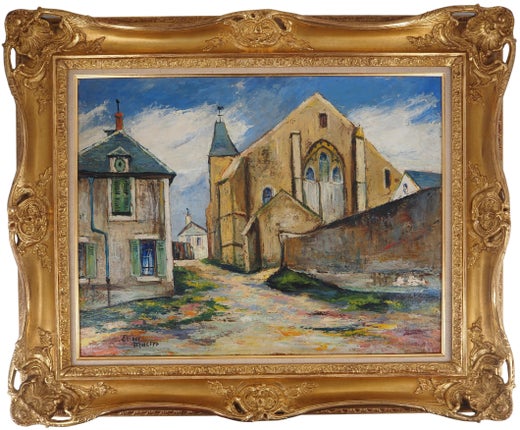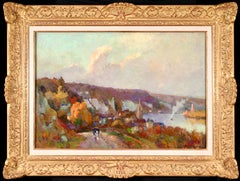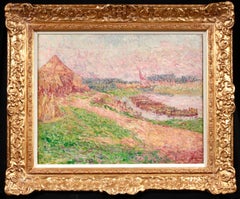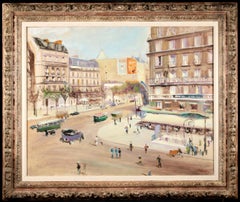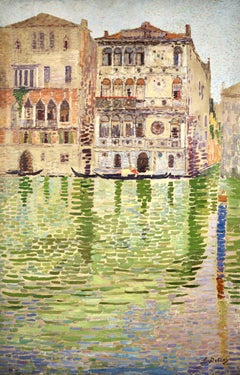Want more images or videos?
Request additional images or videos from the seller
1 of 16
Élisée MacletMontmartre Place Emile Goudeau- Post Impressionist Landscape Oil - Elisee Macletc.1920
c.1920
$10,680.82List Price
About the Item
- Creator:Élisée Maclet (1881 - 1962, French)
- Creation Year:c.1920
- Dimensions:Height: 25 in (63.5 cm)Width: 29 in (73.66 cm)
- Medium:
- Movement & Style:
- Period:
- Condition:Very good condition.
- Gallery Location:Marlow, GB
- Reference Number:Seller: LFA02401stDibs: LU415316227972
Élisée Maclet
Élisée Maclet was born the son of a gardener and a laundress in Picardy. His family was poor and he began work very young as an assistant to his father. Picardy is renowned for its roses, and Maclet used to say that he was born among cabbages and roses. His artistic talent became evident very early on. In spite of paternal opposition, in 1906 Maclet gave up gardening for art and moved to Montmartre, where while painting he supported himself with a variety of casual work (varnishing iron bedsteads, decorating the floats for the gala nights at the Moulin Rouge, washing dishes or opening oysters in restaurants). In a short time Maclet won a circle of admirers. The art dealer, Dosbourg, bought his work, which gave him a fairly reliable source of income and enabled him to devote more time than ever to his art. From Montmartre he launched out into the suburbs of Paris, painting them with the same affection with which he treated the scenes of Montmartre. In 1923 Maclet entered into a contract with a wealthy Austrian manufacturer, Baron von Frey, a condition of which was that he should leave Paris for the south of France, as the Baron sensed that Maclet would know how to handle the brilliant light and intense colours of the Midi. When he made sporadic visits to Paris during his years in the south of France, the painters of Montmartre and Montparnasse considered him a painter on the rise, but the public remained indifferent. In 1957 a Parisian gallery organized a retrospective exhibition of Maclet's work, and the solid rise in the prices of his paintings dates from that retrospective exhibition. The artist had reached the state wherein his work was soundly established across the years.
About the Seller
5.0
Gold Seller
Premium sellers maintaining a 4.3+ rating and 24-hour response times
Established in 2001
1stDibs seller since 2016
708 sales on 1stDibs
Authenticity Guarantee
In the unlikely event there’s an issue with an item’s authenticity, contact us within 1 year for a full refund. DetailsMoney-Back Guarantee
If your item is not as described, is damaged in transit, or does not arrive, contact us within 7 days for a full refund. Details24-Hour Cancellation
You have a 24-hour grace period in which to reconsider your purchase, with no questions asked.Vetted Professional Sellers
Our world-class sellers must adhere to strict standards for service and quality, maintaining the integrity of our listings.Price-Match Guarantee
If you find that a seller listed the same item for a lower price elsewhere, we’ll match it.Trusted Global Delivery
Our best-in-class carrier network provides specialized shipping options worldwide, including custom delivery.You May Also Like
Strasburg. Oil on cardboard, Figurative, Architecture, Polish art
By Magdalena Spasowicz
Located in Warsaw, PL
20th century figurative landscape oil on canvas on board painting by Polish artist Magdalena Spasowicz. Artwork is in classic style, it resembles impressionism. Composition is painted with wide brush strokes. Colors are muted. Artwork depicts a cityscape of Strasburg in France.
MAGDALENA SPASOWICZ Studied painting under prof. Jan Cybis and graphic arts with prof. Tadeusz Kulisiewicz at the Academy of Fine Arts in Warsaw. She received her diploma in 1953. Her works have been presented in numerous exhibitions in Poland and abroad, among others in Warsaw, London, New York, Bratislava, Washington, Moscow, Berlin, Budapest, and are to be found in private and public collections around the world. In 2017 two individual exhibition of the artists took place - at the Regional Museum in Kozienice Palace and at the Museum of Western Mazowsze in Zyrardow. Magdalena Spasowicz has been spending every single moment on painting for many years now. Most of her paintings are monochromatically coloured landscapes, of places where eye cheers soul with a sight close to heart, known and well remembered. French painting of Pissarro and Utrillo has been a very important inspiration for Magdalena Spasowicz. A desire to still-frame every moment when the artist meets Nature and beloved places is an imperative, which obliges to come back to canvas and paint, paint with a total devotion. The artistry of the places represented in the paintings of Magdalena...
Category
21st Century and Contemporary Post-Impressionist Landscape Paintings
Materials
Board, Canvas, Oil
$1,913
H 18.12 in W 21.66 in
The Sea, boats. Oil on canvas, Figurative, Landscape, Marine, Polish artist
By Magdalena Spasowicz
Located in Warsaw, PL
20th century figurative landscape oil on canvas painting by Polish artist Magdalena Spasowicz. Artwork is in classic style, it resembles impressionism. Marine landscapes, seascapes, boats, harbors are motifs in Spasowicz's art to which she often comes back. Composition is painted with wide brush strokes. Colors are muted with stronger accent of red in bottom right corner.
MAGDALENA SPASOWICZ Studied painting under prof. Jan Cybis and graphic arts with prof. Tadeusz Kulisiewicz at the Academy of Fine Arts in Warsaw. She received her diploma in 1953. Her works have been presented in numerous exhibitions in Poland and abroad, among others in Warsaw, London, New York, Bratislava, Washington, Moscow, Berlin, Budapest, and are to be found in private and public collections around the world. In 2017 two individual exhibition of the artists took place - at the Regional Museum in Kozienice Palace and at the Museum of Western Mazowsze in Zyrardow. Magdalena Spasowicz has been spending every single moment on painting for many years now. Most of her paintings are monochromatically coloured landscapes, of places where eye cheers soul with a sight close to heart, known and well remembered. French painting of Pissarro and Utrillo has been a very important inspiration for Magdalena Spasowicz. A desire to still-frame every moment when the artist meets Nature and beloved places is an imperative, which obliges to come back to canvas and paint, paint with a total devotion. The artistry of the places represented in the paintings of...
Category
21st Century and Contemporary Post-Impressionist Landscape Paintings
Materials
Oil, Canvas
Magdalena SpasowiczThe Sea, boats. Oil on canvas, Figurative, Landscape, Marine, Polish artist, 1998
$2,033
H 13.19 in W 21.66 in
Printemps
By Charles Levier
Located in Costa Mesa, CA
A beautiful woman sits at an open window, gazing down at a small bird who has landed nearby in this serene portrait by Charles Levier. Warm orange tones are played off their complements in shades of blue, the artist utilizing several different layers of oils to create a subtle and relaxed view of a spring day near the sea. Beyond the window a small chapel sits on a peninsula, surrounded tranquil blue waters.
This work, like many of Levier's, belongs to the French figurative movement of the Glorious Thirty (Les Trente Glorieuses) - the golden period of thirty years after WWII which were a time of great hope and prosperity in France. Inspired by Hollywood cinema, Charles Levier sought harmony in composition and purity of color and form. His said that his creations represented "a light and delicate world, of dark and subtle shades and colors."
Levier worked in a somewhat abstracted, cubist style. Additionally he often employed the French technique of "cloisonnism" (after the French for "partition"), a style of post-Impressionist painting with bold and flat forms separated by dark contours, also seen in this work. The term was coined by critic Edouard Dujardin on the occasion of the Salon des Indépendants, in March 1888 and was commonly used by artists like Émile Bernard, Louis Anquetin, Paul...
Category
Mid-20th Century Post-Impressionist Figurative Paintings
Materials
Canvas, Oil
Pluie a Venice (Venice in the Rain)
By André Hambourg
Located in Costa Mesa, CA
Pluie a Venice is painted in Hambourg's preferred palette of muted blue-green, grey, and gold with splashes of ruby red, deep blue, and emerald green. The soft colors work well for beach scenes and rainy days such as the ones portrayed in this painting. The impressionistic scene shows multiple pedestrians strolling down the boardwalk, shielding themselves from the rain with colorful umbrellas that provide pops of color and balance the overcast sky.
The background contains a three-masted ship and Piazza San Marco's famous bell tower and Basilica. Hambourg uses the minimum number of brushstrokes necessary to portray ships, seagulls, buildings and people as well as reflections on the glistening sidewalk. The brushstrokes in the sky have an interesting texture that is controlled yet carefree and there is heavy impasto throughout. His portrayal is both realistic and romanticized.
Hambourg was clearly influenced by the great Impressionist artists of earlier generations, perhaps none more than the one with a direct connection to his family. Hambourg's wife, Nicole Rachet, was born into a family with a large collection of works by Impressionist master Eugene Boudin. Rachet's grandfather was a contemporary and friend of Boudin's, and a collector of his work. In their later years, Hambourg and Rachet donated over 300 canvases by Boudin and other artists to the Eugene Boudin Museum in Honfleur, France. It was such a large and important gift that the collection bears...
Category
1960s Post-Impressionist Landscape Paintings
Materials
Canvas, Oil
Femme lisant dans un jardin
By Georges d'Espagnat
Located in Mc Lean, VA
Signed with monogram lower left
* The Robert Lehman Collection at the Metropolitan Museum of Art contains more paintings (nine) by Georges D’Espagnat than any other nineteenth- or ...
Category
1910s Post-Impressionist Figurative Paintings
Materials
Canvas, Oil
Femme à la promenade
By Albert Andre
Located in Mc Lean, VA
Large and historically significant post-impressionist painting by Albert André.
Exhibition:
Exposition Post et Néo-Impressionniste, Durand-Ruel Gallery, Paris, 10–31 March 1899, n...
Category
1880s Post-Impressionist Figurative Paintings
Materials
Canvas, Oil
Haystack with Resting Figures
By John Maclauchlan Milne
Located in Hillsborough, NC
Scottish artist John Maclauchlan Milne, RSA, (1885-1957) is a contemporary of Scottish Colourists Peploe, Fergusson, Cadell and Hunter. Like the...
Category
1920s Post-Impressionist Landscape Paintings
Materials
Canvas, Oil
South of France, Marie Lucie Nessi, Woman Post Impressionist, Oil paint, 1950
By Marie Lucie Nessi
Located in New York, NY
Marie-Lucie Nessi Valtat
South of France, ca. 1950
Oil on canvas mounted on board
13 3/4 x 10 2/3 in l 35 x 27 cm
Frame size: 15 3/4 x 12 2/3 in l 40 x 32 cm
Marie-Lucie Nessi Valta...
Category
1950s Post-Impressionist Figurative Paintings
Materials
Canvas, Oil
Marie Lucie NessiSouth of France, Marie Lucie Nessi, Woman Post Impressionist, Oil paint, 1950, 1950
$1,800
H 13.78 in W 10.63 in
"The Red Bush" Gabriel Godard, Painting, Oil on canvas, French artist, 1979
By Gabriel Godard
Located in New York, NY
Gabriel Godard (1933-2023)
The Red Bush, 1979
Oil on canvas
Artwork: 28 x 20 1/2 in. l 71 x 52 cm
Framed: 31 1/2 x 24 in. l 80 x 61 cm
Signed lower left
Condition: Perfect condition...
Category
1970s Post-Impressionist Landscape Paintings
Materials
Canvas, Oil
$9,500
H 20.48 in W 27.96 in
Horseman in Summer, Marie Lucie Nessi, Woman Post Impressionist, Oil paint, 1950
By Marie Lucie Nessi
Located in New York, NY
Marie-Lucie Nessi Valtat
Horseman in Summer, ca. 1950
Oil on canvas mounted on board
10 2/3 x 13 3/4 in l 27 x 35 cm
Frame size: 12 2/3 x 15 3/4 in. l 32 x 40 cm
Marie-Lucie Nessi V...
Category
1950s Post-Impressionist Figurative Paintings
Materials
Oil, Canvas
$1,800
H 10.63 in W 13.78 in
More From This Seller
View AllDuclair - La Seine - Post Impressionist Oil, River Landscape by Robert Pinchon
By Robert Antoine Pinchon
Located in Marlow, Buckinghamshire
Fauvist signed oil on canvas riverscape circa 1920 by French post impressionist painter Robert Antoine Pinchon. The work depicts a view of the R...
Category
1920s Post-Impressionist Landscape Paintings
Materials
Canvas, Oil
Loading Flax on the Barges - Post Impressionist Landscape Oil by Modest Huys
Located in Marlow, Buckinghamshire
Signed divisionist landscape oil on canvas by Belgian post impressionist painter Modest Huys. This stunning piece depicts workers on the bank of a river loading flax onto barges.
Signature:
Signed lower right
Dimensions:
Framed: 23"x27"
Unframed: 15"x19"
Provenance:
Private collection - Belgium
Modest Huys (25 October 1874, in Zulte – 30 January 1932, in Zulte) was a Flemish impressionist and luminist painter, who is regarded as one of the greatest Belgian painters of the 20th century.
From a young age, Modest Huys worked in his father's painting and decorating business and later studied at the "Gentse Nijverheidschool" (Ghent Industrial School). In 1891 or 1892, he came into contact with Emile Claus, who encouraged his artistic inclinations. In 1900, he enrolled at the Royal Academy of Fine Arts where his teachers were Eugène Joors and Frans Van Leemputten but he never completed his studies. It was about this time that he became lifelong friends with the author Stijn Streuvels.
In 1902, he debuted at the Sint-Lucasgilde in Kortrijk and began to exhibit more widely. He spent time in Meetjesland, painting landscapes. From 1905, he participated in the exhibitions of Vie et Lumière...
Category
Early 1900s Post-Impressionist Landscape Paintings
Materials
Canvas, Oil
Les Grands Boulevards - Post Impressionist City Landscape Oil by Lucien Adrion
By Lucien Adrion
Located in Marlow, Buckinghamshire
Signed figures in landscape oil on canvas circa 1920 by French post impressionist painter Lucien Adrion. The painting depicts people going about their daily lives on the streets of Paris, France on a sunny spring day with trams travelling along the boulevards.
Signature:
Signed lower right
Dimensions:
Framed: 33"x39"
Unframed: 26"x32"
Provenance:
Galerie Vildrac - Paris (labels verso)
Lucien Adrion was born May 25, 1889 in Strasbourg, France. He was was a French Post-Impressionist painter, draftsman, and printmaker known for his depictions of the French countryside and beaches, as well as Parisian life including landscape, still life, figure and landmark paintings. He began his initial studies in Strasbourg as a technical draughtsman. In 1907, at the age of eighteen, he left his hometown Strasbourg and traveled to Paris, where he found employment in a large drafting company to work as a fashion illustrator. Adrion changed his mind upon arrival and rather than working for a large company, he decided to peruse his artistic career by traveling to London, Munich and Frankfurt. As the World War broke out he had to go to Berlin, where he studied as an engraver with Hermann Struck, who was also the teacher of Marc Chagall. He remained in Berlin until the war ended and after the demobilization, Lucien would study engraving under Franz Ritter von Struck...
Category
1920s Post-Impressionist Landscape Paintings
Materials
Canvas, Oil
Venice - Post Impressionist Venetian Landscape Oil Painting by Leon Detroy
By Leon Detroy
Located in Marlow, Buckinghamshire
Signed landscape oil on canvas circa 1910 by French post impressionist painter Leon Detroy. This work is painted in a divisionist style and depicts a view of gondolas on the canal in...
Category
Early 20th Century Post-Impressionist Landscape Paintings
Materials
Canvas, Oil
La Chapelle - Post Impressionist Figurative Oil by Ferdinand du Puigaudeau
By Ferdinand du Puigaudeau
Located in Marlow, Buckinghamshire
Signed and dated post impressionist figurative oil on canvas by French painter Ferdinand du Puigaudeau. This beautiful and large work depicts dozens of churchgoers in traditional Bre...
Category
1910s Post-Impressionist Figurative Paintings
Materials
Canvas, Oil
Barques au Bois de Boulogne - Fauvist Landscape Oil Painting by Louis Valtat
By Louis Valtat
Located in Marlow, Buckinghamshire
Signed fauvist oil on canvas laid on panel riverscape circa 1925 by French painter Louis Valtat. The work depicts several boats being rowed on River Seine in Bois de Boulogne - a for...
Category
1920s Fauvist Landscape Paintings
Materials
Oil, Panel, Canvas
